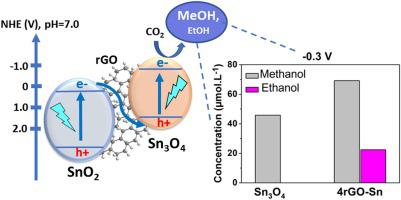Journal of CO2 Utilization ( IF 7.2 ) Pub Date : 2021-02-12 , DOI: 10.1016/j.jcou.2021.101460 F.C. Romeiro , B.C. Silva , A.S. Martins , M.V.B. Zanoni , M.O. Orlandi

|
This study reports on the photoelectrochemical reduction of CO2 to methanol using Sn3O4 and reduced graphene oxide-tin oxide (rGO-Sn) nanocomposite synthesized through the microwave-assisted hydrothermal method. The resulting rGO-Sn nanocomposite exhibited enhanced activity and good stability during photoelectrochemical CO2 reduction explained by Z-scheme electron transport. Graphene oxide (GO) has played a crucial role in the chemical composition and morphology of nanocomposites. The interaction between GO and Sn2+ ions during synthesis promoted the formation of the SnO2 phase in the nanocomposite, thus generating mixed rGO/Sn3O4/SnO2 phases (the rGO-Sn nanocomposite). Remarkable selectivity for CO2/methanol conversion was obtained for both Sn3O4 and the nanocomposite at different potentials, in which the nanocomposite presented the highest conversion to methanol with a faradaic efficiency of 45 % at −0.3 V vs. Ag/AgCl. The improved activity of the nanocomposite was ascribed to the efficient use of solar energy (UV + visible light), to the decrease in electronic recombination in nanocomposite, which enabled an efficient electron-hole separation on the surface of the nanocomposite, and to the presence of rGO being combined with Sn3O4 and SnO2 structures, which ensured a faster charge transport rate. This study reveals the potential of rGO-Sn nanocomposites as photocathodic material for solar-to-chemical energy conversion.
中文翻译:

rGO-氧化锡纳米复合材料在将CO 2选择性还原为甲醇中的优异性能
该研究报道了利用Sn 3 O 4和微波辅助水热法合成的还原型氧化石墨烯-氧化锡(rGO-Sn)纳米复合材料将CO 2光电化学还原为甲醇。生成的rGO-Sn纳米复合材料在光电化学CO 2还原过程中表现出增强的活性和良好的稳定性,这可通过Z方案电子传输来解释。氧化石墨烯(GO)在纳米复合材料的化学组成和形态中起着至关重要的作用。合成过程中GO和Sn 2+离子之间的相互作用促进了纳米复合材料中SnO 2相的形成,从而生成混合的rGO / Sn 3 O 4。/ SnO 2相(rGO-Sn纳米复合材料)。对于Sn 3 O 4和纳米复合材料,在不同电势下均获得了显着的CO 2 /甲醇转化选择性,其中纳米复合材料在-0.3 V电压下相对于Ag / AgCl表现出最高的甲醇转化率,法拉第效率为45%。纳米复合材料活性的提高归因于太阳能(UV +可见光)的有效利用,纳米复合材料中电子复合的减少,这使得能够在纳米复合材料表面上进行有效的电子-空穴分离以及存在rGO与Sn 3 O 4和SnO 2结合的过程结构,确保了更快的电荷传输速率。这项研究揭示了rGO-Sn纳米复合材料作为光阴极材料用于太阳能到化学能转化的潜力。











































 京公网安备 11010802027423号
京公网安备 11010802027423号